Stony Brook, NY, April 15, 2014 - The hard clam or northern quahog, Mercenaria mercenaria, is one of the most valuable seafood products in the Northeast. Since the 1990s, several Northeastern states have suffered severe losses in hard clam stocks due to a fatal disease caused by a protistan parasite called Quahog Parasite Unknown or simply QPX. New York Sea Grant has funded numerous research projects conducted at the Marine Animal Disease Lab at Stony Brook University to identify the QPX organism and its effects on the hard clam.
One recently completed study comparing different brood stocks demonstrated the genetic origin of clam resistance toward QPX. The research team led by Dr. Bassem Allam used several different approaches to characterize the hard clam’s immune response toward QPX infection. By using both naturally and experimentally infected clams and comparing susceptible and resistant clam stocks, researchers could identify several immune genes that are modulated by the exposure to QPX including those involved in pathogen recognition and killing. Results also demonstrated a major effect of temperature on clam immunity and resistance to QPX. Overall, results allowed the identification of candidate biomarkers and molecular mechanisms characteristic of both resistance to, and dysfunctions caused by, QPX. Candidate biomarkers should be validated in the framework of future functional investigations to facilitate the screening and selection of resistant clam stocks.
The Marine Animal Disease Laboratory (MADL)
Frequent response to disease events such as the QPX outbreak in the New York metro area underscores the fragility of marine organisms and the need to understand the factors that affect their health. In 2000, the New York State Legislature established the Marine Disease and Pathology Research Consortium at the School of Marine and Atmospheric Sciences (SoMAS) of Stony Brook University. Under the auspices of this Consortium--comprised of SoMAS, Cornell University, the NYS Department of Environmental Conservation, New York Sea Grant, and others--the Marine Animal Disease Laboratory (MADL) has since become a fully-functioning facility for conducting research related to the occurrence, causes, and effects of marine animal diseases. The MADL is recognized as a leader in the Northeast for studying finfish and shellfish diseases. With more than 15,000 specimens analyzed since its inception, the MADL provides vital diagnostic services to state and local governments, non-profit organizations and aquaculture businesses. The MADL also monitors the health of commercially-important marine organisms in collaboration with resource management agencies.
MADL faculty and students maintain vibrant and innovative research to develop new disease diagnostic techniques, investigate animal immunity to infections, create new tools to select disease-resistant strains for aquaculture, and study the effects of the globally-changing environment on diseases and animal physiology. This research program contributes to a better understanding of marine organisms and their diseases, and supports optimal exploitation of marine resources in the state.
About the postcards ...
New York Sea Grant, in partnership with the Marine Animal Disease Laboratory, created an exciting collection of seven educational postcards describing the rich and diverse shellfish species living in the marine waters around Long Island, and are being threatened by changing climate and disease.
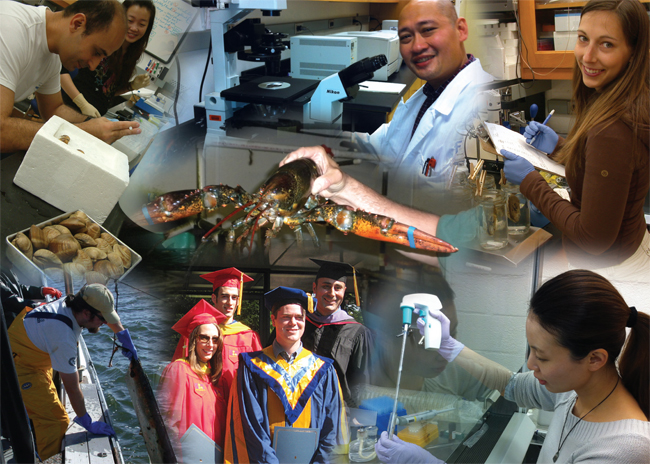
MADL faculty researchers supervise post graduate students and post doctorates who contribute to field and laboratory activities. The MADL partners with agencies and connects with the commercial fishing industry and aquaculture operations to conduct health monitoring programs, and respond to disease events. Graduate students complete advanced degree programs and find employment in government and the private sector.
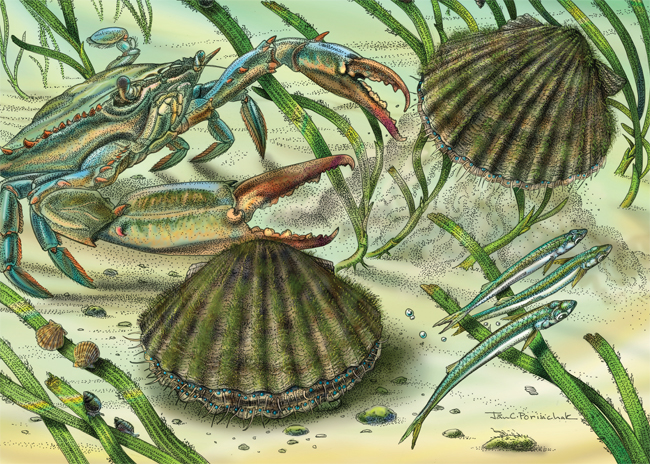
Jewels of the Bay
Scallops were used as pig feed in the 1800s when farmers believed this diet improved the flavor of the meat. Bay scallops are found in shallow bays and estuaries along the Atlantic and Gulf coasts of the US. Waters around eastern Long Island (NY) supported a large bay scallop fishery and Peconic bay scallops are legendary. The long history of scallops in New York is the reason why it was given the iconic stature of official state shell.
These little jewels have 18 pairs of blue eyes set along the margin of the shell that are used to detect shadows and movements. Adult scallops live detached and can actively swim to flee from predator crabs and starfish. The strong adductor muscle (the meat sold in the market) is used to open and close the shells and allows ‘clapping,’ a fast movement which propels the shellfish through the water.
Once a thriving fishery, repeated outbreaks of brown tide, a harmful alga, completely devastated bay scallop populations and current abundance is a mere 1-2 percent of historic levels and this has led to extensive attempts at stock recovery. Stony Brook University’s Marine Animal Disease Laboratory investigates basic physiological processes of scallops as well as factors affecting their health.
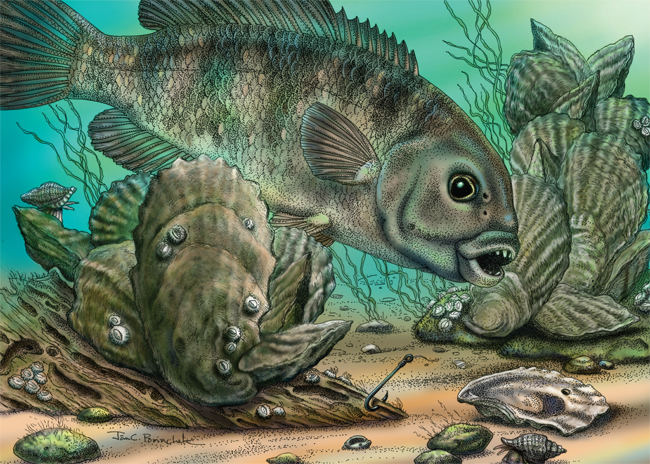
The Perfect Bivalve
Over 85 percent of oyster reefs have been lost globally, making them one of the most severely impacted ecosystems on the planet. Oyster reefs were once a dominant feature of estuaries along the Atlantic and Gulf of Mexico coasts with healthy communities of Eastern Oyster. Oysters play an extremely important role in reef ecology and are regarded as an ecosystems engineer. They thrive in a range of salinity from brackish to full strength seawater, and they occur mostly in sub-tidal areas.
By serving as breakwaters that reduce shoreline erosion, oyster reefs also create a refuge for prey and predator marine life. These filter feeding bivalves remove fine organic particles that are suspended in the water, which allows light to penetrate to the bottom benefiting living benthic communities in shallow bays.
In New York, it takes approximately two weeks for fertilized eggs to develop into miniature oysters that settle and grow for up to three years when they mature; they can live for many years if left undisturbed.
Passage of several disease outbreaks in New York has caused a drastic reduction in oyster populations. Stony Brook University’s Marine Animal Disease Laboratory provides diagnostic services to the shellfish industry and performs research investigating the mechanisms of oyster resistance to infectious diseases to help oyster restoration efforts.

Diverse Ecosystems in Long Island’s Bays
New York’s coastline features many bays, inlets, and barrier beaches that are shaped by forces of nature and harbor a profusion of marine flora and fauna. The topography is a composition of diverse habitats including sandy beaches and dunes, cliffs and bluffs, estuaries, wetlands, rocky and intertidal flats, and so much more.
Finfish and shellfish harvested around Long Island support viable commercial fisheries, unlike aquatic systems in the Great Lakes. Tiny microscopic plankton form the base of the food web that supports large predators.
Beneath the surface at the bottom of Long Island’s coastal bays are complex system of eelgrass beds where juvenile fish, crustaceans, bivalves, and other species take refuge. Once abundant, eelgrass fields experienced a passage of diseases over the years, including wasting disease, causing as much as 90 percent reduction.
In a temperate climate, shellfish reefs are comparable to tropical coral reefs, sharing many similarities in their physical and ecosystem function. Filter feeding bivalves remove suspended particles, including toxic algae, from the water column allowing more light to reach the bottom where it promotes eelgrass growth.
Stony Brook University’s Marine Animal Disease Laboratory investigates finfish and shellfish health, as well as other basic physiological processes such as filter-feeding, to better understand the factors affecting animals, and overall ecosystems health.
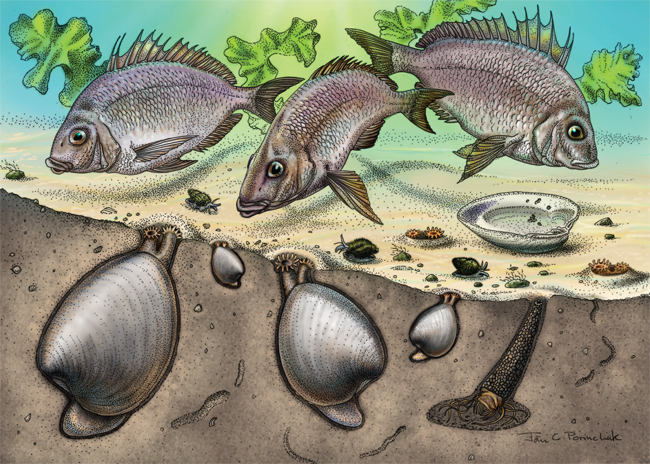
Burrows in the Sand
Hard clams (or ‘clams’) are a native bivalve on the eastern seaboard of North America from Florida to Prince Edwards Island. Several names are used in the market to describe different sizes – little necks, top necks, cherrystones, and chowders. Another name that is common in New England is quahog, which comes from the Native Americans who ate these clams and used the shells to make beads to trade as a type of currency.
Hard clams spend most of their lives buried with their two siphons protruding just above the substrate. They burrow deeper when disturbed to avoid predators such as crabs, conch, and snails. The bands on a hard clam’s outer shell are indicative of its age, very much like the marks on a tree, and one year of growth is equivalent to a full band.
These clams are a hardy species that support a robust fishery and aquaculture activities (currently the most economically valuable fishery in New York State). Development of this fishery in the Northeast is hampered by QPX – a pathogen that is harmless to humans and detrimental to hard clam populations. Stony Brook University's Marine Animal Disease Laboratory works with managers and the industry to monitor and research the factors affecting disease development and resistance in New York.
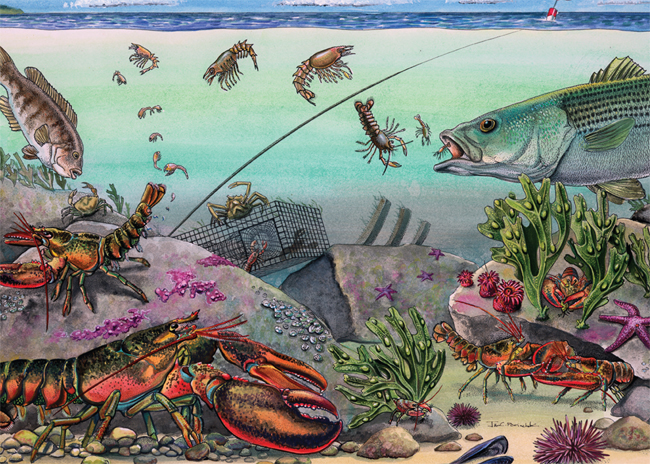
Lobster Tales
The American lobster is a clawed lobster that is caught in abundance in northeastern North America. It supports one of the oldest fisheries in the United States, dating back to the Native Americans who used lobsters as fertilizer for their crops and bait on hooks to catch fish. Lobsters were covered with seaweed and cooked over hot rocks to eat – a cooking technique that gave rise to the New England clam bake.
Lobsters were very cheap in the colonial era when they were used to feed prisoners, slaves, and apprentices, and this practice continued for several decades afterwards. Prices rose very quickly in the 1880s after diners in New York City and Boston started to demand lobsters in fine dining establishments, elevating this seafood to a delicacy.
Long Island Sound (NY) was the third largest lobster producer in the United States until a mortality event ravished this population in 1999. Stony Brook University’s Marine Animal Disease Laboratory (MADL) discovered a new disease known as calcinosis, in Long Island Sound lobsters. Calcinosis is harmless to humans and it has been linked to thermal stress that is caused by climate change. MADL research is studying emergent diseases such as lobster shell disease, and the ability of lobster populations to resist infections in a changing environment.
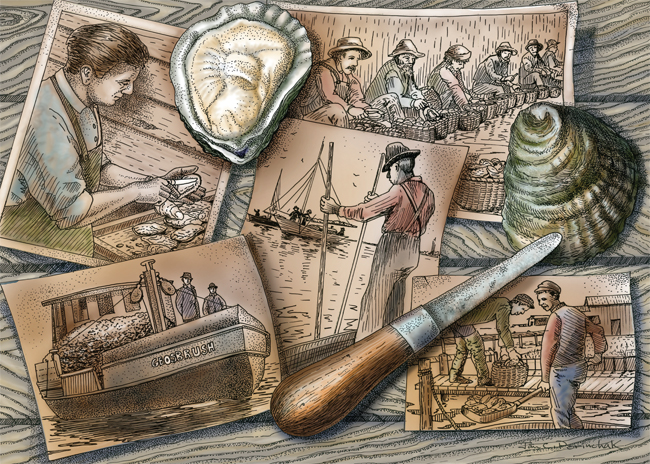
Credit: Artwork inspired by historical photographs available at the Long Island Maritime Museum Library
The Pearl in the Big Apple
Oysters were once synonymous with New York City (NYC), and shells discarded by the Native Americans living on Manhattan Island formed huge piles called middens. Dutch settlers didn’t find pearls, but, they were delighted to reap bountiful oyster reefs around Ellis and Liberty Islands (known as Little Oyster and Big Oyster Islands to the Dutch settlers). As New York City became a magnet for the wealthy in the 19th century, the oyster was king and a major player on gastronomic palates.
Hundreds of oyster sloops and barges dotted the busy waterways, floating factories carrying shuckers working 10-hour shifts, six days a week, opening as many as 1,000 oysters an hour. Oysters were cheap food fare consumed by the rich and poor, available in fine restaurants, cellars, and even on street corners alongside the popcorn, hot dog, and peanut stands. Piles of oyster shells were common sightings until they were burned, or recycled as mortar paste for building construction, or used for road paving.
Booming construction in the 1920s ultimately contributed to this industry’s decline. Wild harvest oyster gardens have since disappeared and been replaced with thriving shellfish growing businesses across Long Island. Serious challenges facing NY's shellfishing industry today include habitat loss, water quality and shellfish diseases. Scientists at Stony Brook University’s Marine Animal Disease Laboratory support the industry by providing diagnostic services and research aimed at enhancing the production of high quality livestock.
More Info: New York Sea Grant
New York Sea Grant (NYSG), a cooperative program of Cornell University
and the State University of New York, is one of 33 university-based
programs under the National Sea Grant College Program (NSGCP) of the
National Oceanic and Atmospheric Administration (NOAA). The NSGCP
engages this network of the nation’s top universities in conducting
scientific research, education, training and extension projects designed
to foster science-based decisions about the use and conservation of our
aquatic resources. Through its statewide network of integrated
services, NYSG has been promoting coastal vitality, environmental
sustainability, and citizen awareness about the State’s marine and Great
Lakes resources since 1971.
For updates on Sea Grant activities: www.nyseagrant.org has RSS, Facebook, Twitter, and YouTube links. NYSG also offers a free e-list sign up via www.nyseagrant.org/coastlines for NY Coastlines, its flagship publication, which, in 2014, merges with the program's e-newsletter, Currents. NY Coastlines is published several times a year.